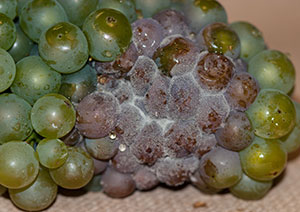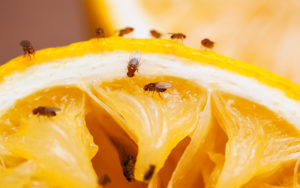Ask a Viticulturist: How to prevent Sour rot in the vineyard
A disease complex that hits you right in the c(rot)ch
We’ve got our first Ask-a-Viticulturist question! This one is from a grower in Ukiah, Mendocino County, California. This grower writes:
We had a problem with sour rot in some Sauvignon Blanc this year. How can one prevent it?
He followed up with:
The sour rot that developed this year may have been encouraged by the sustained above normal heat that we were experiencing after veraison. It was identified by the light tan discoloration of the infected berries and the vinegar smell and jet black masses of spores next to the stems of the clumps of infected berries when pulled away from the stem. It was not limited to dense canopy areas. In fact, is seemed to thrive in fully exposed low vigor areas as well.
Wow, I haven’t heard of Marciume acido (Sour rot) since I lived in Italy, and even then it was never much of an issue when compared to the intense pressure of Downy mildew and Botrytis. Northern Italy is very different from Northern California in that the former gets quite a bit of rain during the summer. Most places that see sour rot as a problem are similarly moist during the growing season. These are places like Upstate New York, Niagara, and pretty much anywhere in Virginia and the entire east coast. For this reason, I’m a bit surprised to hear about a case of this stinky problem occurring this far west, but this is what I love about agriculture so let’s dive in.
What does Sour rot look like?
Many readers may have only heard about Sour rot in passing if at all. Grape are affected in the later stages of maturity (15 Brix and above). Infected clusters take on a shiny, brownish color shown in the following images. The berry skins are necrotic and appear crisp and papery. The berries themselves are often empty inside or oozing. This is in contrast to the purplish berries and gray fuzz associated with Botrytis cinerea (although Botrytis may play a role). Most notable of sour rot is its distinct vinegary odor. This is due to fungal oxidation of sugar to ethanol and then the bacterial oxidation of ethanol to acetic acid.


What are the pathogens/vectors?
Cornell University[i] has done quite a bit of research into the agents responsible for Sour rot. They’ve found that the first step of infection requires the presence of a native yeast and native acetic bacteria.
Yeast metabolize sugar in the grape and turn it into ethanol, much like they do during fermentation. The native yeast could be our old friend Saccharomyces cervisiae, which is found on the outside of healthy berries and, although not the most prevalent population-wise in the vineyard, is certainly the most competitive. Other yeasts, some of which have been isolated inside grape berries, include Hanseniaspora uvarum and Pichia kluyveri. Aspergillus niger, which is not a yeast, but a filamentous fungus, can also be responsible.
The second step in the equation is performed by acetic bacteria Glucanobacter spp. and Acetobacter spp. These bacteria oxidize the ethanol created by yeasts to acetic acid, creating the sour smell.
In the Cornell study, no combination of yeast and bacteria were associated with Sour rot on their own. The presence of our next player, Drosophila spp. (fruit flies), seems to be the imperative third step in this complex. The complete role fruit flies play is not entirely understood. They can vector yeasts and bacteria as well as feed on them. Fruit flies also carry other kinds of microbes in their gut, so it’s possible that one of these stomach organisms is really the third agent in causing disease. Either way, Sour rot is not observed if Drosophila spp. isn’t there.

[i] Wilcox, W., Loeb, G. & Hall, M., 2017. Defining and Developing Management Strategies for Sour Rot. Appelation Cornell: Research News from Cornell’s Viticulture and Enology Program, Research Focus(2017-3).
Other factors
While you need all three of these factors to bring about Sour rot, wounds are the starting point. Most insects can’t puncture the cuticle of the grape berry on their own (You’ll want to control for those that can i.e. wasps, grapevine moths, Drosophila suzukii). Opening up the grape facilitates microbial and insect feeding. It also allows oxygen into the grape, which is needed to oxidize ethanol to acetic acid. Volatized ethanol and acetic acid attract more insects and subsequently more vectoring and infection.
Sour rot appears to be variety specific. Like Botrytis, thin skinned grapes are more susceptible as are tight clusters where berries get pushed out or ruptured by the growth of their neighbors. If I were going to see Sour rot anywhere in Northern California, Sauvignon Blanc would be the cultivar I’d expect to see it on.
Temperature and humidity are important factors when it comes to microbial activity. Stagnant humidity and warm temperatures are an ideal environment for fungi and bacteria. I haven’t seen what the vineyard in question looks like, but I have seen many overgrown Sauvignon Blanc vineyards here in Sonoma County. Excessive vigor, shading, overirrigating, overcropping, and rough mechanical operations could create a perfect storm for Sour rot. Growers also tend to plant more prestigious (and more remunerative) varieties in the best drained, best-exposed areas, reserving poorly-drained, shaded areas for a little Sauvignon Blanc. This tendency doesn’t help matters when it comes to disease.
Oddly enough, spraying for Botrytis can also exacerbate Sour rot.[i] Late stage anti-botrytis fungicides are usually very specific as broad-spectrum fungicides can impede fermentation. Remember that the microflora of your vineyard is an ecosystem all its own. You can’t knock out the king and expect there’s not going to be some underling clawing his way into the power vacuum. Likewise, botrytis keeps a lot of other microbes at bay. When he goes away, the yeasts and bacteria responsible for Sour rot can run rampant.
[i] Suzzi, G. & Tofalo, R., 2014. Microbiologia enologica, Milano: Edagricole. Pages 203-204.
How do I manage Sour rot?

The simplest way to handle Sour rot is to prevent a favorable microclimate from forming in the first place. Manage vigor by limiting irrigation and nitrogen fertilization. Remove leaves early on and do so aggressively if the area your farming is prone to stagnant humidity. Don’t allow your cover crop to go wild in the tractor row and especially not the vine row. Again, if you’re in a place where water sticks around too long in the soil during the vegetative growth stage, you’ll need to keep after your vegetation.
Above all, avoid wounding. You shouldn’t be doing much in the way of canopy management after bunch closure. If you’re dropping any fruit, it should be done cleanly with little damage to any of the crop you want to retain. As mentioned earlier, there are some insects that can puncture the grape cuticle and they should be scouted and dealt with if necessary.
The study at Cornell found that the best results for controlling an infection of Sour rot came from treating both with an antimicrobial and an insecticide before the onset of symptoms. Antimicrobials used include Kocide 3000, Oxidate 2.0, and Fracture, although they saw little effect from just treating with these products. Treating for microbes on the surface of the grape doesn’t work if they’re already inside via wound sites. Even treating with an insecticide alone proved more effective than just using antimicrobials.
Note that we are not recommending any specific treatments here. It’s just a discussion.
What else can it be?
Sour rot is a rarity in Northern California. Although anything is possible, we want to consider what else it might be especially since we don’t have a photo of the infected vines.
Black rot (Giugnardia bidwelii): This fungus can look at times like Sour rot but present pycnidia that resemble black spots. Black rot tends to like warm and wet weather though, so it would also be odd to find this guy in a Mendocino vineyard, especially in a year as dry as 2020. Photo credit (Kentucky Pest News, 2020).


Phomopsis viticola: Although we’re used to seeing Phomopsis on the basal parts of the shoots, late infection of the clusters looks similar to Sour rot. Required conditions are similar to that of Sour rot and is likewise pretty rare in this region. Photo credit (Grapes, 2019).
Sooty mold: The presence of jet-black spores at the base of the berry doesn’t jibe with Sour rot’s symptoms. It could be caused by sooty mold brought on by an insect’s honeydew (most likely from a scale or mealy bug, although many insects produce honeydew) or juicing of the berries from another cause, even birds. This mold only infects the surface of the grape but could bring about wounds to the underlying tissue. In this way, Sour rot could be a secondary infection. This would explain why exposed, dry, low-vigor areas were affected. Photo credit (Wine Australia).

I hope this helps! Keep the questions coming my fellow vignerons!
Photo citations
Black Rot of Grapes (2020). Kentucky Pest News. Available at: https://kentuckypestnews.wordpress.com/2020/05/19/black-rot-of-grapes/ [Accessed December 14, 2020].
Bordelon, B., Grapes: The Sour Rot Situation. Facts for Fancy Fruit. Available at: https://fff.hort.purdue.edu/article/grapes-the-sour-rot-situation/ [Accessed December 14, 2020].
Grapes, 2019. Phomopsis Cane and Leaf Spot and Fruit Rot of Grapes. Grapes. Available at: https://grapes.extension.org/phomopsis-cane-and-leaf-spot-and-fruit-rot-of-grapes/ [Accessed December 14, 2020].
Grapevine scale and sooty mould. Wine Australia. Available at: https://www.wineaustralia.com/growing-making/pest-and-disease-management/grapevine-scale-and-sooty-mould [Accessed December 14, 2020].
Hall, M., 2020. Research In Plain English | Viticulture And Enology. [online] Grapesandwine.cals.cornell.edu. Available at: <https://grapesandwine.cals.cornell.edu/newsletters/appellation-cornell/2018-newsletters/issue-34-august-2018/reserach-plain-english/> [Accessed 14 December 2020].
(Main photo) Know your grapevine bunch rots. Agriculture and Food. Available at: https://www.agric.wa.gov.au/summer/know-your-grapevine-bunch-rots [Accessed December 14, 2020].
Ministry of Agriculture, F.and F., 2016. Botrytis Bunch Rot of Grape. Province of British Columbia. Available at: https://www2.gov.bc.ca/gov/content/industry/agriculture-seafood/animals-and-crops/plant-health/insects-and-plant-diseases/grapes/botrytis-bunch-rot-of-grape [Accessed December 14, 2020].
Under the microscope: Drosophila melanogaster (2017). The Biomedical Scientist. Available at: https://thebiomedicalscientist.net/news/under-microscope-drosophila-melanogaster [Accessed December 14, 2020].

